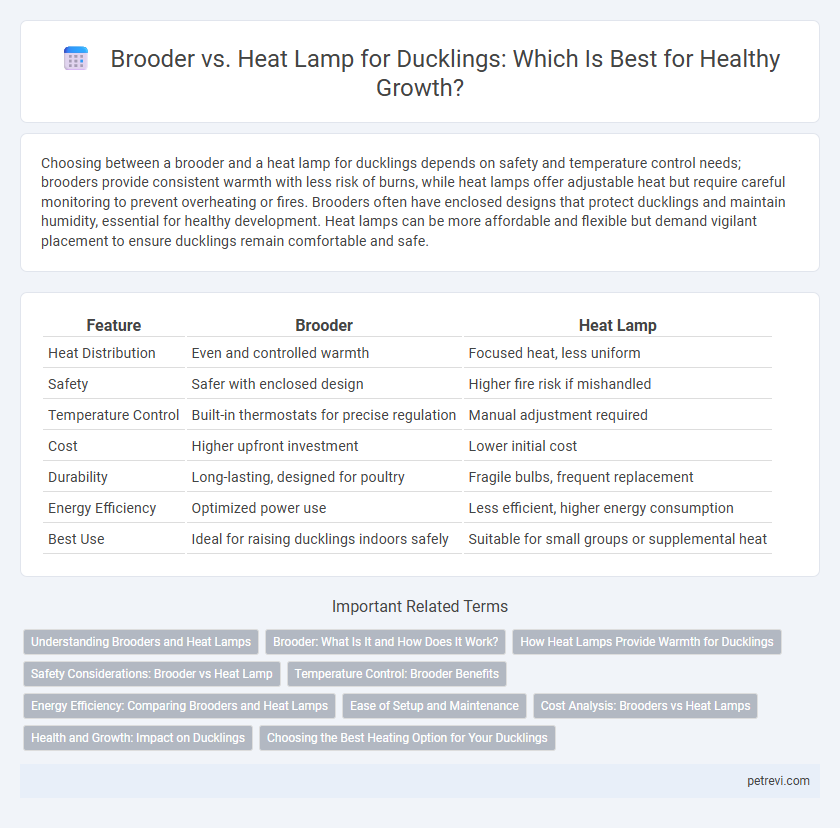Choosing between a brooder and a heat lamp for ducklings depends on safety and temperature control needs; brooders provide consistent warmth with less risk of burns, while heat lamps offer adjustable heat but require careful monitoring to prevent overheating or fires. Brooders often have enclosed designs that protect ducklings and maintain humidity, essential for healthy development. Heat lamps can be more affordable and flexible but demand vigilant placement to ensure ducklings remain comfortable and safe.
Table of Comparison
| Feature | Brooder | Heat Lamp |
|---|---|---|
| Heat Distribution | Even and controlled warmth | Focused heat, less uniform |
| Safety | Safer with enclosed design | Higher fire risk if mishandled |
| Temperature Control | Built-in thermostats for precise regulation | Manual adjustment required |
| Cost | Higher upfront investment | Lower initial cost |
| Durability | Long-lasting, designed for poultry | Fragile bulbs, frequent replacement |
| Energy Efficiency | Optimized power use | Less efficient, higher energy consumption |
| Best Use | Ideal for raising ducklings indoors safely | Suitable for small groups or supplemental heat |
Understanding Brooders and Heat Lamps
Brooders provide consistent, controlled warmth essential for duckling development by maintaining optimal temperatures and minimizing risks like overheating or fire hazards common with heat lamps. Heat lamps offer adjustable heat sources but require careful monitoring and proper installation to prevent accidents and ensure uniform warmth. Choosing an appropriate heat source depends on factors such as brood size, environmental conditions, and safety considerations to promote healthy growth and reduce stress in ducklings.
Brooder: What Is It and How Does It Work?
A brooder is a controlled environment designed to provide consistent warmth and safety for ducklings, mimicking the natural heat given by a mother duck. It typically consists of an insulated enclosure with a heat source, such as a heat plate or lamp, maintaining an optimal temperature range of 85-90degF (29-32degC) during the first week, gradually decreasing as the ducklings grow. The brooder's design prevents overheating and chilling, promoting healthy development and reducing stress among hatchlings.
How Heat Lamps Provide Warmth for Ducklings
Heat lamps provide consistent, targeted warmth essential for ducklings' development by emitting infrared heat that mimics natural sunlight, promoting steady body temperature regulation. Unlike brooders that offer enclosed warmth, heat lamps allow adjustable heat zones, enabling ducklings to move closer or farther based on their comfort needs. These lamps reduce risks associated with overcrowding and support optimal growth by maintaining an ideal temperature range between 85-90degF during the critical first weeks.
Safety Considerations: Brooder vs Heat Lamp
Brooders provide a controlled environment with consistent warmth, minimizing fire hazards and reducing risks of overheating or drafts for ducklings. Heat lamps, while effective for heat, pose safety concerns such as accidental burns, electrical fires, and uneven temperature distribution requiring constant monitoring. Ensuring proper placement, secure fixtures, and reliable temperature regulation is crucial to prevent injuries and ensure the safety of young ducklings in both setups.
Temperature Control: Brooder Benefits
A brooder provides precise temperature control essential for the healthy development of ducklings, maintaining a consistent warmth that mimics natural brooding conditions. Unlike heat lamps, brooders distribute heat evenly, reducing the risk of overheating or chilling, which is critical in the first weeks of life. Reliable temperature regulation in a brooder supports optimal growth rates, reduces stress, and prevents common cold-related illnesses in ducklings.
Energy Efficiency: Comparing Brooders and Heat Lamps
Brooders typically offer greater energy efficiency for ducklings by maintaining consistent temperatures with insulated designs, reducing heat loss compared to heat lamps. Heat lamps consume more electricity due to continuous high wattage output and less targeted heat distribution. Choosing energy-efficient brooders can lower utility costs while providing stable warmth essential for duckling growth.
Ease of Setup and Maintenance
A brooder offers a controlled environment with built-in temperature regulation, making it easier to maintain consistent warmth for ducklings compared to a heat lamp, which requires frequent adjustments to prevent overheating or chilling. Heat lamps are simpler to set up initially, needing only a secure hanging position and proper wattage bulb, but they demand constant monitoring to ensure safety and stable temperature. Choosing a brooder reduces daily maintenance and risks, providing a more reliable and convenient solution for raising healthy ducklings.
Cost Analysis: Brooders vs Heat Lamps
Brooders typically have a higher initial cost but offer better energy efficiency and temperature consistency, making them more cost-effective over time for raising ducklings. Heat lamps have a lower upfront price but consume more electricity and pose a higher risk of fire, potentially increasing long-term expenses and safety concerns. Evaluating energy consumption, maintenance, and safety factors is essential for optimizing costs in duckling brooding environments.
Health and Growth: Impact on Ducklings
A brooder provides consistent, evenly distributed warmth essential for the optimal growth and immune development of ducklings, reducing stress and vulnerability to illness. Heat lamps, while convenient, often create uneven temperature zones that can lead to overheating or chilling, impairing duckling health and increasing mortality risk. Proper temperature regulation through brooders fosters more stable body temperature, promoting stronger respiratory health and accelerated growth rates in young ducklings.
Choosing the Best Heating Option for Your Ducklings
Choosing the best heating option for ducklings involves evaluating brooder boxes and heat lamps based on temperature control and safety. Brooders provide consistent warmth with less risk of burns, while heat lamps offer adjustable heat levels but require careful monitoring to prevent overheating. Prioritizing reliability and the ability to create a stable, warm environment enhances duckling growth and overall health.
Brooder vs Heat Lamp for Ducklings Infographic

 petrevi.com
petrevi.com